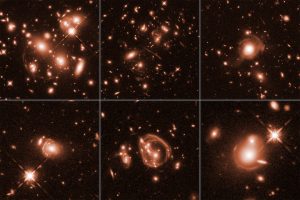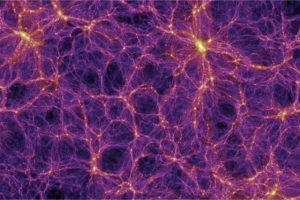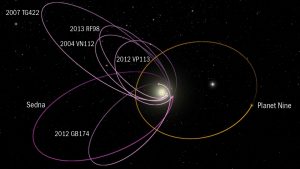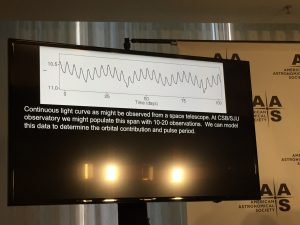Editor’s Note: This week we’re at the 230th AAS Meeting in Austin, TX. Along with author Benny Tsang from Astrobites, I will be writing updates on selected events at the meeting and posting each day. Follow along here or at astrobites.com. The usual posting schedule for AAS Nova will resume next week.
Press Conference: Inconstant Stars (by Benny Tsang)
Our morning press conference featured four new studies on variable stars, ones that don’t shine steadily. The first presentation was by Rodolfo Montez from the Smithsonian Astrophysical Observatory, who spoke about a symbiotic system (a variable binary star system with a red giant transferring mass to a white dwarf) called R Aquarii. The key discovery is a large-scale X-ray jet structure on the northern side of the system, as revealed by the Chandra telescope. This discovery helps us piece together a more complete historical record of the jet ejection, crucial for understanding the connection between jets and binary orbits. [Full press release]
Thomas Kirkman (St. John’s University) then shared a puzzling result he found with his group of undergraduate researchers. Their target of observation was an eclipsing Cepheid variable in the Milky Way (TYC 1031 1262 1). A Cepheid variable is a pulsating star that changes in brightness as it expands and contracts. When Cepheid variables are in binary systems, variability due to pulsation is complicated by eclipses by the dim star, adding another level of modulation in brightness (see the light curve in the figure). Kirkman and his group found that the binary system exhibited a decreasing period (took longer and longer to go around), whereas previous observers had found an increasing trend. These results suggest a puzzling oscillation in the orbital period — something that definitely calls for more follow-up!
The next remarkable discovery was a pre-cataclysmic variable with the shortest period found to date (WD 1202-024), reported by Lorne Nelson from Bishop’s University. The variable brightness can be modeled very well as a white dwarf with a brown dwarf companion. Since only about 1% of white dwarfs have brown dwarfs as companions, this is indeed a rare find. The lack of mass transfer (what causes cataclysmic variables to vary in brightness) signatures is the reason that we call it a “pre-cataclysmic” source. It is speculated the binary orbit will shrink in size by emitting gravitational waves and become a real cataclysmic variable. But we may have to wait for ~250 million years before it happens.
GALEX (the Galaxy Evolution Explorer) is an all-sky surveying spacecraft built to observe the night sky in ultraviolet wavelengths, which can distinguish photons arriving 0.005 second apart! Its high sensitivity allows short-timescale brightness variations to be detected from low-mass cool stars. Chase Million (Million Concepts) has built a brand-new data analysis pipeline engineered to search GALEX data for flares from cool stars. It turns out that many of these flares, both big and small, were found. Habitable planets lie closer to cooler stars, so the energy from the flares might impinge on these planets’ surfaces. The discovery of the many flares in the GALEX data therefore has critical implications for the general habitability of other worlds. [Full press release]
Plenary Session: Our Future in Space (by Susanna Kohler)

Wan Hu, a Chinese official who allegedly attempted to travel to the Moon. [US Civil Air Patrol via NASA]
Current prospects in the U.S. are looking progressively bleaker for government-driven space exploration. Past programs — like the Space Shuttle — are disappearing, and the budget for new programs is shrinking. The cost of space missions suddenly seems much more manageable when you change perspective, however: Impey made the unexpected comparison of space-mission costs relative to the production budget for major movies. Guess which one is, on average, larger today?
Impey: Producing the median movie costs more than the median space mission now! #aas230 pic.twitter.com/DEkLcvXTtD
— AAS Nova (@AASNova) June 6, 2017
So if you can front the money for a movie about going to space, why not instead front the money for the actual mission to space? This is the thinking behind the new private-sector-driven era of space exploration.
Major companies like Space X and Blue Origin are putting themselves on the map, and programs like Google’s Lunar XPRIZE have encouraged an expanding field of players. Commercial space travel is becoming ever more prevalent; a total of 7 space tourists have gone up to spend a vacation at the ISS, for instance, paying millions of dollars for the privilege. And roughly two years ago marked the first time in our history that the majority of space launches to low-Earth orbit were commercial — a significant milestone.
So what does the future hold? Impey believes that space exploration will continue to be driven primarily by the private sector. Some of his rapid-fire predictions for the future include successful asteroid mining endeavors, development of a permanent Mars colony, tourism to Europa, and exploration of Alpha Centauri. As for whether or not these things will actually come to pass — we’ll just have to wait and see.
You can find out more about Impey in this interview by Amber Hornsby.
Press Conference: Galaxies, Clusters & Voids (by Susanna Kohler)
This afternoon’s press conference launched with a presentation by Jason Chu (University of Hawaii Institute for Astronomy) on a peculiar breed of galaxies: Luminous Infrared Galaxies, or LIRGs. LIRGs are extremely bright, emitting hundreds of billions or even trillions of solar luminosities in primarily infrared wavelengths. Many are interacting or merging galaxies — and as such, they’re much more common in the early universe (when galaxies were more likely to run into each other since the universe was smaller). Nearby LIRGs, however, offer a useful opportunity to study what’s happening in these galaxies in detail. Chu presented a series of far-infrared observations from Herschel mapping the 200 brightest LIRGs in the nearby universe as part of the Great Observatory All-sky LIRG Survey (GOALs). The observations of the GOALS sources are publicly available, and scientists can use the data to explore properties of these galaxies that were previously impossible to measure. [Full press release] [Original article]

Hubble images of six distant ultra-bright infrared galaxies, which are gravitationally lensed by foreground galaxies. [NASA, ESA, and J. Lowenthal (Smith College)]
Next up, Jack Burns (University of Colorado Boulder) discussed “banging” galaxy clusters. In particular, he presented observations of a specific cluster: Abell 115, located 2.4 billion light-years away. Abell 115 is actually a violent early-stage collision of two subclusters, each containing hundreds of galaxies. New X-ray temperature maps of Abell 115 reveal a region of incredibly hot (170 million Kelvin) gas in the center between the merging subclusters. Burns suggests that the turbulence of this extreme region may be responsible for the temperature, as the energy of the merging cluster motion is converted into thermal energy by the mixing actions of turbulence. [Full release here]

This simulation of the universe shows its overall structure of filaments and voids. [Millennium Simulation]
Plenary Session: Planet Nine from Outer Space (by Benny Tsang)

Orbits of the six long-period Kuiper belt objects (purple) appear to be clustered in one direction. The orange orbit shows the possible orbit of Planet 9. [Image credit: Caltech/Robert Hurt]
The story started with the discovery of the Kuiper belt, a swarm of rocks going around the Sun beyond the orbit of Neptune. Most of these asteroids’ orbits can be understood with the eight planets we already have. However, when it comes to the bodies with periods longer than 4,000 years, their orbits are absurd — these long orbits seem to cluster together in space (the purple orbits in the figure), which is statistically extremely unlikely to occur by chance.
It gets more and more intriguing as we have discovered more and more anomalies in our solar system.
- Sedna (2003 VB12) and Biden (2012 VP113) are two Kuiper belt objects with large orbits that never get too close to Neptune. Traditional theories on the early evolution of our solar system can’t explain the existence of such objects.
- Kuiper belt objects have been discovered with orbits nearly perpendicular to typical planets. This also can’t be explained by our eight-planet solar system.
- A mysterious object called Niku was found to orbit the Sun with a retrograde (moving opposite to nearly everything else in the Solar system), near-circular, and extremely tilted orbit.
- The Sun’s rotational axis was found to have a 6° misalignment with the global orbital axis of the eight known major planets.
Back in October, my former student Gongjie Li and I made a wager. She bet P9-KBO dynamics is strictly secular, I bet resonant. Answer soon. pic.twitter.com/DEYi4B1yZk
— Konstantin Batygin (@kbatygin) January 9, 2017
All these “small enough to ignore, big enough to be relevant” anomalies could be explained by adding a planet with ~10 Earth masses in an orbit of ~500 AU — Planet 9! Using numerical simulations, Konstantin has successfully reproduced every single one of these anomalies. Whether we will find Planet 9 is still up in the air (in space I mean), but Konstantin’s remarkable discoveries have already made the Solar System great if you ask me! Konstantin is also a rockstar; don’t forget to check out his interview with Amber Hornsby.
Plenary Session: Flows and Flares Around the Nearest Supermassive Black Hole — Sgr A* (by Susanna Kohler)
Did you know that our galaxy likely once hosted an active galactic nucleus? The Milky Way’s central supermassive black hole, the four-million-solar-mass Sgr A*, is much quieter today — but it still exhibits a little bit of action. Daniel Wang (University of Massachusetts) took the last plenary session of the day as an opportunity to catch us all up on some of the activity around the central black hole in our galaxy.
Why do we care about Sgr A*? Besides the intrigue of learning about our local environment, Sgr A* has the benefit of being observable. While the nuclei of other galaxies may be only a few pixels in our observations, we’re able to observe the central region of our galaxy on a broad range of scales. On arcminute scales, we can see the central star cluster and colliding stellar winds. Zooming in to a few arcseconds we can see the actual motion of stars as they orbit Sgr A*. And in the future, we hope to even get down to scales where we can resolve the shadow of the black hole itself, using effectively an Earth-sized telescope called the Event Horizon Telescope. What we learn about the center of the Milky Way by studying the region around Sgr A*, we can hopefully apply to understand the nuclei of more distant galaxies.
Over the span of his talk, Wang introduced us to a number of studies of activity near Sgr A* — including both flares and quiescent emission. The bulk of Sgr A*’s quiescent emission comes from the outer regions around the black hole (i.e., 10,000–100,000 Schwarzschild radii away); this is in contrast to active galactic nuclei, in which the innermost regions dominate the emission. Interestingly, the outflow from Sgr A* very nearly balances the inflow, with less than 1% of the accreting matter actually falling into the black hole.Sgr A*’s activity becomes even more interesting when we look at its flaring behavior. We’ve observed about 100 X-ray flares total (mostly with Chandra, XMM-Newton, Swift, and NuSTAR), and we estimate that Sgr A* probably flares at a rate of about two times per day. These flares typically last only about an hour in X-rays. What causes them? Wang presents two possibilities: the more mundane solution of magnetic reconnection (as is the case with solar flares), and the sexier alternative of tidal disruption of asteroids. The latter model fits the data slightly better in terms of the flare distributions and their durations, but the emission models haven’t been developed enough to say anything with certainty yet.
Wang: What generates the flares? Possibly magnetic reconnection. More exciting option: tidal disruption of asteroids! #aas230 pic.twitter.com/wMIBZhGXbr
— AAS Nova (@AASNova) June 6, 2017
To conclude, Wang walks through the big picture of the life cycle of galactic nuclear activity, which begins with cold gas accretion. This leads to star formation and resulting strong hot cluster winds, which then blow out the remaining cold gas and turn off accretion. When the winds weaken, the cycle can begin anew. This cycle is regularly interrupted by disruptions of passing asteroids, planets, stars, or dense clouds.
You can read more about Wang in this interview by Chris Faesi.




3 Comments
Pingback: AAS 230: Day 2 – MeasurementDataBases for Industry & Science
Pingback: Day 1 AAS
Pingback: Von den Pressekonferenzen der 230. AAS-Tagung | Skyweek Zwei Punkt Null